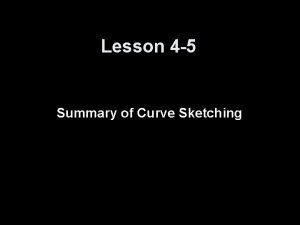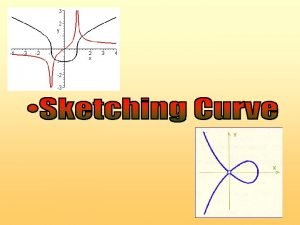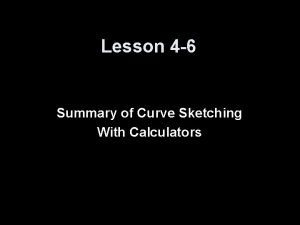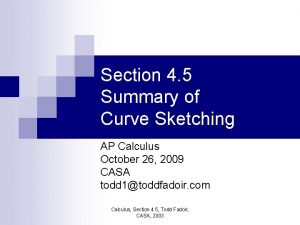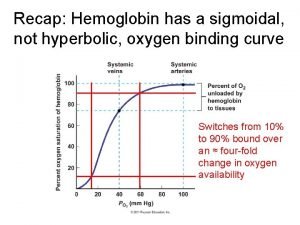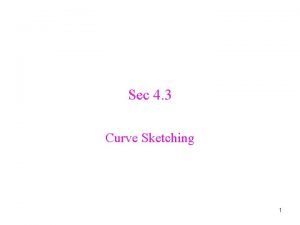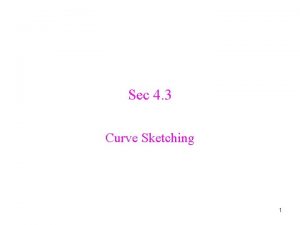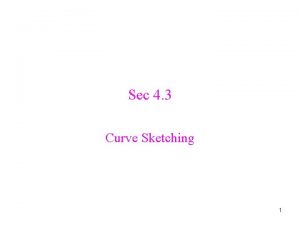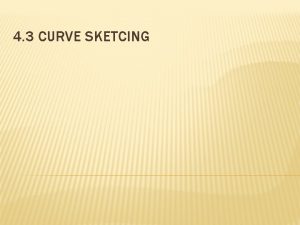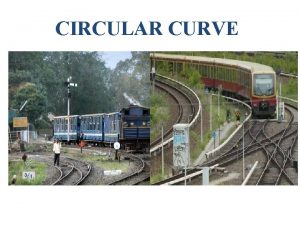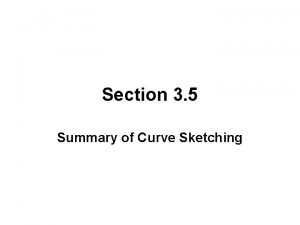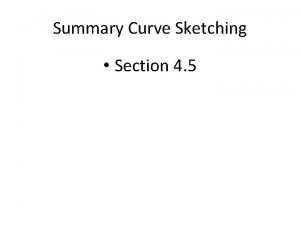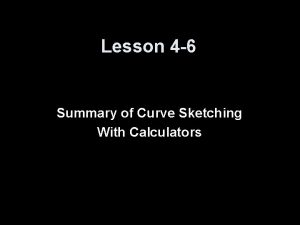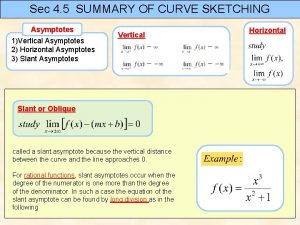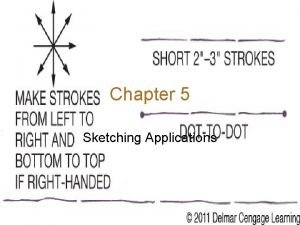Lecture 17 Curve Sketching Last Lectures Summary We



































- Slides: 35

Lecture 17 Curve Sketching

Last Lecture’s Summary We covered Sec 16. 2: Identification of Maxima and Minima • Relative Extrema (maxima and minima) • Absolute Maxima and Minima • Critical Points • First and Second Derivative Tests for Relative Extrema

Today We will cover sections 16. 3 and 16. 4: • Curve Sketching • Restricted Domain Considerations • Procedure for Identifying Absolute Maxima and Minima

Curve Sketching functions is facilitated with the information we have acquired in this chapter. One can get a feeling for the general shape of the graph of a function without determining and plotting a large number of ordered pairs.

Key Data Points In determining the general shapes of the graph of a function, the following attributes are the most significant. • • Relative maxima and minima. Inflection points. x and y intercepts. Ultimate direction


1 - Relative Maxima and Minima •



2 - Inflection Points •


3 - Intercepts •

4 - Ultimate Direction •


RESTRICTED-DOMAIN CONSIDERATIONS In this section we will examine procedures for identifying absolute maxima and minima when the domain of a function is restricted.





II Compute the values of f(x) at the two endpoints of the domain [f(xl) and f(xu). III Compare the values of f(x*) for all relevant critical points with (xl) and (xu). The absolute maximum in the largest of these values. The absolute minimum is the smallest of these values.




Step II The values of f (x) at the endpoints of the domain are

Step III Comparing f (2), f (6), and f (10), we find the absolute minimum of -13 occurs when x = 6 and the absolute maximum of 481/3 occurs when x = 10. The figure presents a sketch of the function.










Review Covered sections 16. 3 and 16. 4: • Curve Sketching • Restricted Domain Considerations • Procedure for Identifying Absolute Maxima and Minima Next, we’ll start Chapter 17: Application of Optimization.
 (x²+4²-1)³-x²4³=0
(x²+4²-1)³-x²4³=0 Sketching cubics
Sketching cubics Curve sketching calculator
Curve sketching calculator Curve sketching ap calculus
Curve sketching ap calculus Randy pausch last lecture summary
Randy pausch last lecture summary 01:640:244 lecture notes - lecture 15: plat, idah, farad
01:640:244 lecture notes - lecture 15: plat, idah, farad Hyperbolic vs sigmoidal curve
Hyperbolic vs sigmoidal curve S curve and j curve
S curve and j curve Balanced occlusion
Balanced occlusion Biotic potential and environmental resistance
Biotic potential and environmental resistance Rick trebino lectures
Rick trebino lectures Lectures paediatrics
Lectures paediatrics Data mining lectures
Data mining lectures Medicinal chemistry lectures
Medicinal chemistry lectures Uva presentation template
Uva presentation template Cs614 short lectures
Cs614 short lectures Planning a software project
Planning a software project Molecular biology lecture
Molecular biology lecture Radio astronomy lectures
Radio astronomy lectures Dr sohail lectures
Dr sohail lectures Utilities and energy lecture
Utilities and energy lecture Introduction to web engineering
Introduction to web engineering Do words have power
Do words have power Frcr physics lectures
Frcr physics lectures Frequency of xrays
Frequency of xrays Cs106b lectures
Cs106b lectures Blood physiology guyton
Blood physiology guyton Aerodynamics lectures
Aerodynamics lectures Theory of translation lectures
Theory of translation lectures Power system lectures
Power system lectures What is text linguistics
What is text linguistics Translation 1
Translation 1 Digital logic design lectures
Digital logic design lectures Jim kurose
Jim kurose Hegel three forms of art
Hegel three forms of art Nuclear medicine lectures
Nuclear medicine lectures
